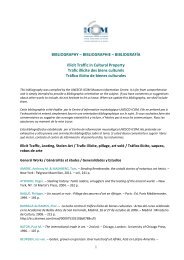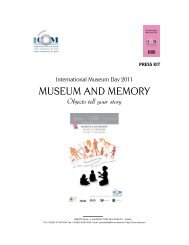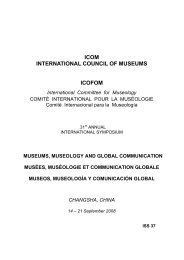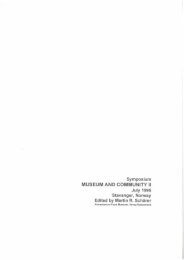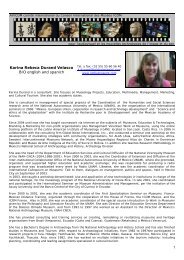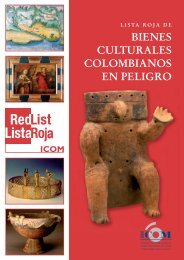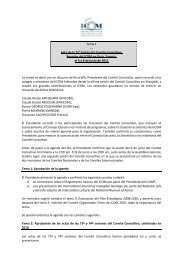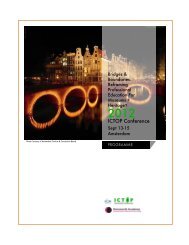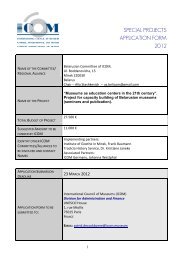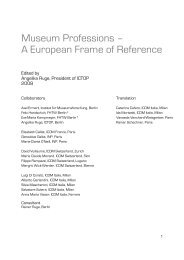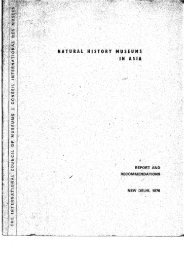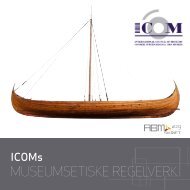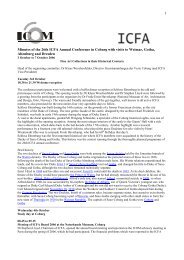Key Concepts of Museology - ICOM
Key Concepts of Museology - ICOM
Key Concepts of Museology - ICOM
You also want an ePaper? Increase the reach of your titles
YUMPU automatically turns print PDFs into web optimized ePapers that Google loves.
40<br />
ciples <strong>of</strong> history, history <strong>of</strong> art, and<br />
archaeology, the last two categories<br />
essentially belong to the category<br />
<strong>of</strong> immovable heritage. Until<br />
very recently the Directorate <strong>of</strong> the<br />
Heritage <strong>of</strong> France, whose principle<br />
purpose was the preservation <strong>of</strong><br />
historical monuments, was separate<br />
from the Directorate <strong>of</strong> the Museums<br />
<strong>of</strong> France (French Museums Board).<br />
Today it is not unusual to fi nd people<br />
supporting this differentiation,<br />
which is at the very least strict. Even<br />
when expanded worldwide under<br />
the aegis <strong>of</strong> UNESCO, the idea that<br />
is fostered especially by <strong>ICOM</strong>OS,<br />
the equivalent <strong>of</strong> <strong>ICOM</strong> for historical<br />
monuments, is fi rst <strong>of</strong> all based<br />
essentially on monuments and on<br />
groups <strong>of</strong> monuments and sites.<br />
Thus the Convention on the World<br />
Cultural Heritage stipulates: “For<br />
the purposes <strong>of</strong> this Convention, the<br />
following shall be considered cultural<br />
heritage: – monuments: architectural<br />
works, works <strong>of</strong> monumental<br />
sculpture and painting, […] – groups<br />
<strong>of</strong> buildings: groups <strong>of</strong> separate or<br />
connected buildings, […] because <strong>of</strong><br />
their architecture, […] – sites: works<br />
<strong>of</strong> man or the combined works <strong>of</strong><br />
nature and man, […]. For the purposes<br />
<strong>of</strong> this Convention the following<br />
shall be considered natural heritage:<br />
natural features, […] – geological<br />
and physiographical formations<br />
[…] – natural sites or natural areas.”<br />
(UNESCO 1972).<br />
2. From the mid 1950s, the notion<br />
<strong>of</strong> heritage gradually incorporated<br />
all material evidence <strong>of</strong> man and his<br />
environment and became conside-<br />
rably wider. Thus folklore heritage,<br />
scientifi c heritage and then industrial<br />
heritage were gradually integrated<br />
into the concept <strong>of</strong> heritage. The defi -<br />
nition <strong>of</strong> heritage in French-speaking<br />
Québec also followed this general<br />
tendency: “May be considered heritage<br />
all objects or groups <strong>of</strong> objects,<br />
material or intangible, that are collectively<br />
recognised or appropriated<br />
for their value as evidence and historical<br />
memory and which merit being<br />
protected, preserved, and enhanced”<br />
(Arpin, 2000). This concept refers to<br />
all natural or man-made goods and<br />
values, whether material or intangible,<br />
without restriction <strong>of</strong> time or<br />
space, whether they be simply inherited<br />
from the forbears <strong>of</strong> earlier generations<br />
or gathered and preserved to<br />
be transmitted to the descendants<br />
<strong>of</strong> future generations. Heritage is a<br />
public good; its preservation must<br />
be assumed by the community when<br />
individuals fail to do so. Individual<br />
local natural and cultural characteristics<br />
contribute to the conception<br />
and building <strong>of</strong> the universal character<br />
<strong>of</strong> heritage. The concept <strong>of</strong><br />
heritage differs from the concept <strong>of</strong><br />
inheritance with regard to time and<br />
events: whereas inheritance is identifi<br />
ed immediately after a death or<br />
when there is a transferral <strong>of</strong> goods<br />
from one generation to another, heritage<br />
defi nes all the goods received or<br />
gathered and safeguarded by earlier<br />
generations that will be transmitted<br />
to their descendants. To a certain<br />
extent, heritage can be a line <strong>of</strong> inheritances.



